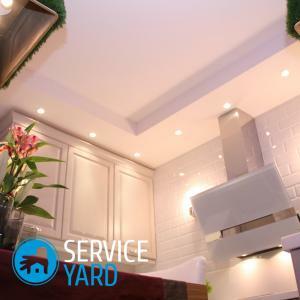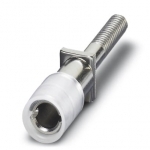
- Types of hoods and a brief description of them
- The main stages in connecting the kitchen hood
- Install the flat cooker hood
- How to install the dome kitchen hood?
- How to install corrugation correctly?
Kitchen extractor is a device that is not required for installation, but still, most people buy it. Some choose together with the delivery and installation of this unit, well, some decide to install it independently, although they do not always know how to connect the hood, where it is necessary to begin. We will try for you to disclose these topics in this article, so that you can successfully cope with the goal.
to the contents ↑Types of hoods and a brief description of them
Kitchen hoods are of the following types:
- Wall. They have a fairly diverse body design, which is why with aesthetics in your kitchen everything will be in order. It is fastened directly to the wall above the stove.
- Corner. An excellent option for those who have a small kitchen, where every centimeter must be used extremely functionally. It is fixed on the wall in the corner.
- Suspended or, as they are called, flat. They are directly above the stove, under the cupboard.
- Recessed. Installed straight into the cabinet itself.
- Island. This is the most versatile type of kitchen hoods. It is possible to mount such equipment in almost any area of your kitchen. Usually, they are used for large kitchens, where all the kitchen furniture is in the middle of the room.
The main stages in connecting the kitchen hood
Before you connect the kitchen hood, the furniture or the headset must already be in place. Thus, you will understand where you should connect the hood.
Choose the right place for the
. When choosing the installation site, take into account the following recommendations:
- It should be located directly above the plate, and under no circumstances should be smaller than the plate.
- The hood must be positioned no lower than 60 centimeters from the plate itself. In the instructions, this moment is usually registered.
- The upper threshold is still better to install, given the growth of the hostess of the kitchen, in order to make it as comfortable as possible during cooking.
At what distance is it necessary to install the cooker hood?
The answer will depend directly on the hood model that you have selected.
Each extractor should be accompanied by an instruction that indicates at what distance it needs to be mounted.
As a rule, install a hood from 65-90 centimeters from the level of the plate. The lower threshold can not be exceeded in any case, because the extractor itself, or its individual parts, can begin to melt.
Important! For electric boards, the threshold is even lower, 65-70 centimeters, well, for gas stoves it is more than 65-90 centimeters.
Once you have correctly determined the type of construction and the location of its installation, it's time to get down to business and plug in the hood.
Install the anti-return valve
It is located in front of the ventilation shaft. The procedure for doing this work, which is necessary to connect the hood in the kitchen:
- In order to work comfortably, you can temporarily install it on your kitchen cabinet. More carefully, the valve will come up somewhat later.
- When the case comes up as needed, inside the cabinet, markings are made to drill out the holes.
- Remove the cabinet, cut the necessary holes in the bottom of the wall in order to install the firecrackers.
Important! Similarly, holes are made for the duct.
We connect the air duct:
- Fix the corrugation, it is desirable that it is in the form of a square.
- Cut the corners and turn them out.
- Fasten the flapper so that it connects your corrugation to the ventilation shaft.
Important! In the event that there are gaps of a sufficiently large size, seal them with an ordinary mounting foam, small slots can be processed with a silicone-based sealant.
We install the hood:
- It is hung on self-tapping screws and depends on the method of attachment.
- Fix the corrugation on the hood with a special harness.
- Check operation, and in case everything is in order, put on the upper cover of your kitchen hood.
Important! In order to effectively connect the kitchen hood with your own hands, consider one nuance during the installation of the vent: the less the number of bends, the better and more powerful will be the air draft.
to the contents ↑Installing the flat cooker hood
The flat design gives a real opportunity to connect the hood if there is no ventilation duct. It is easily and quickly installed. On this device, there were pre-installed fastenings in order to install it.
There are 2 ways to install a flat hood:
- U-shaped frame. Using self-tapping screws, attach the frame directly to the wall - it serves as a catch directly for the hood.
- Self-tapping screws, also called plumbing. They look like a standard samorez on the one hand. Well, on the other hand, they have a thread on which a metal nut is wound. The dowels are driven into the wall, the body of the hood itself is fixed by means of a nut on the necessary from the wall.
 It only remains to fix the flat hood carefully, after that check its operability, connect it to the network. If everything is in order, put on the decorative cap.
It only remains to fix the flat hood carefully, after that check its operability, connect it to the network. If everything is in order, put on the decorative cap.
Important! This type of hood works according to the recirculation mode, that is, it purifies the air with built-in filters. Do not forget that it is necessary to change filters at least 2 times a year.
to the contents ↑How to install a cupola cooker hood?
Let's talk a little about the options for this hood, namely those that are on the market:
- Fireplaces, also called wall-mounted, are mounted on a wall. They are very similar in design to the ventilation system directly for fireplaces.
- Corner - these hoods are rarely found in kitchens, namely when the stove is in a corner.
- Island - such hoods are installed in large enough kitchens, mainly in the kitchens of the public catering, when the stove is in the center of the kitchen. They are attached to the ceiling.
Important! These devices are made of enamel or stainless steel, much less often from wood or plastic.
Features of the selection and operation of the
The dome hood is capable of operating in a variety of modes. If the duct is laid on the street or to the ventilation system, it simply takes the air out of your room.
It happens that the duct can not be laid, then you can put the circulating installation, because it will let the air through the filter and return it back to the room. There are such dome hoods that are able to work in both versions.
Connection bases
In order to connect the extractor of this type with your own hands:
- Move the corrugation to the ventilation system of the building, connect the device to the network using a socket and a plug.
- You may need to increase the corrugation or the wiring, so it's better to use the help of professionals.
- In case you decide to do absolutely all the work yourself, first equip the kitchen with furniture. And only after that you can work on marking the location of the hood, given the height of its location.
- Let's start preparing the fasteners. Drill out or hollow out holes for ordinary dowels. Bolts will be bolted to them, on which you will have to put the base of your hood.
- Observe the tightness during the connection of a special exhaust hood with air ducting.
- Next, check the operation of the device, and then put on the upper hood of the hood.
How to install the corrugation correctly?
If with the connection of the hood in terms of installation of the hull itself there are practically no problems, but with respect to the corrugation they are most often present. Let's figure out what to do in this or that case:
- If the vent is directly above the cooker, you can connect it together with the hood with small adapters. But often they are separated by a much larger distance. In this case, install a special air duct, which is designed for extraction. It represents either an absolutely smooth plastic pipe, or corrugated plastic or aluminum.
- Choosing a smooth pipe, whether round or square, additionally purchase connecting knees that can help bypass the corners. In addition, the adapter is useful in order to fix the corrugation on the hood, as well as for the vent.
- If you have the opportunity to hide the air duct inside the wall cabinet, it is better to use the corrugation, since it is cheaper and easier to install. Adapters are not required, because the corrugation perfectly passes around all corners.
- Before installing, maximally stretch the corrugation in order to reduce noise during exhaust operation.
- Corrugate the corrugations on the hood with a clamp, and on the vent for the ventilation system with a special grille.
Important! When choosing the diameter of the pipe, be guided precisely by the size of the outlet opening of your hood.
As you can see, connecting a kitchen hood is not so difficult, the main thing is to know the correct sequence of actions. Now you have it, so from now on your kitchen will have only pleasant aromas from baking or stew, but not gary or chemistry.


